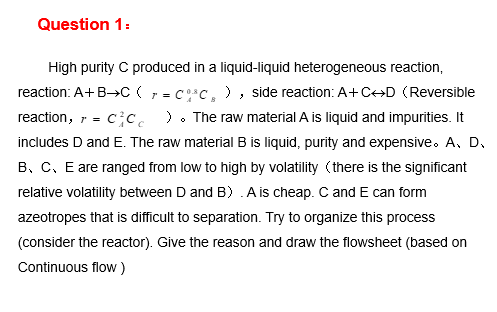High purity C produced in a liquid-liquid heterogeneous reaction, reaction: A+B→C (, = cC, ), side reaction: A+C+D (Reversible reaction, r = Cc. ). The raw material A is liquid and impurities. It includes D and E. The raw material B is liquid, purity and expensive. A, D, B, C, E are ranged from low to high by volatility (there is the significant relative volatility between D and B) .A is cheap. C and E can form azeotropes that is difficult to separation. Try to organize this process (consider the reactor). Give the reason and draw the flowsheet (based on Continuous flow )
High purity C produced in a liquid-liquid heterogeneous reaction, reaction: A+B→C (, = cC, ), side reaction: A+C+D (Reversible reaction, r = Cc. ). The raw material A is liquid and impurities. It includes D and E. The raw material B is liquid, purity and expensive. A, D, B, C, E are ranged from low to high by volatility (there is the significant relative volatility between D and B) .A is cheap. C and E can form azeotropes that is difficult to separation. Try to organize this process (consider the reactor). Give the reason and draw the flowsheet (based on Continuous flow )
Introduction to Chemical Engineering Thermodynamics
8th Edition
ISBN:9781259696527
Author:J.M. Smith Termodinamica en ingenieria quimica, Hendrick C Van Ness, Michael Abbott, Mark Swihart
Publisher:J.M. Smith Termodinamica en ingenieria quimica, Hendrick C Van Ness, Michael Abbott, Mark Swihart
Chapter1: Introduction
Section: Chapter Questions
Problem 1.1P
Related questions
Question

Transcribed Image Text:Question 1:
High purity C produced in a liquid-liquid heterogeneous reaction,
reaction: A+B→C (, = C*c, ), side reaction: A+C→D (Reversible
reaction, r = c c. ). The raw material A is liquid and impurities. It
includes D and E. The raw material B is liquid, purity and expensive. A, D.
B, C, E are ranged from low to high by volatility (there is the significant
relative volatility between D and B) .A is cheap. C and E can form
azeotropes that is difficult to separation. Try to organize this process
(consider the reactor). Give the reason and draw the flowsheet (based on
Continuous flow)
Expert Solution
This question has been solved!
Explore an expertly crafted, step-by-step solution for a thorough understanding of key concepts.
Step by step
Solved in 2 steps with 2 images

Recommended textbooks for you

Introduction to Chemical Engineering Thermodynami…
Chemical Engineering
ISBN:
9781259696527
Author:
J.M. Smith Termodinamica en ingenieria quimica, Hendrick C Van Ness, Michael Abbott, Mark Swihart
Publisher:
McGraw-Hill Education

Elementary Principles of Chemical Processes, Bind…
Chemical Engineering
ISBN:
9781118431221
Author:
Richard M. Felder, Ronald W. Rousseau, Lisa G. Bullard
Publisher:
WILEY

Elements of Chemical Reaction Engineering (5th Ed…
Chemical Engineering
ISBN:
9780133887518
Author:
H. Scott Fogler
Publisher:
Prentice Hall

Introduction to Chemical Engineering Thermodynami…
Chemical Engineering
ISBN:
9781259696527
Author:
J.M. Smith Termodinamica en ingenieria quimica, Hendrick C Van Ness, Michael Abbott, Mark Swihart
Publisher:
McGraw-Hill Education

Elementary Principles of Chemical Processes, Bind…
Chemical Engineering
ISBN:
9781118431221
Author:
Richard M. Felder, Ronald W. Rousseau, Lisa G. Bullard
Publisher:
WILEY

Elements of Chemical Reaction Engineering (5th Ed…
Chemical Engineering
ISBN:
9780133887518
Author:
H. Scott Fogler
Publisher:
Prentice Hall


Industrial Plastics: Theory and Applications
Chemical Engineering
ISBN:
9781285061238
Author:
Lokensgard, Erik
Publisher:
Delmar Cengage Learning

Unit Operations of Chemical Engineering
Chemical Engineering
ISBN:
9780072848236
Author:
Warren McCabe, Julian C. Smith, Peter Harriott
Publisher:
McGraw-Hill Companies, The